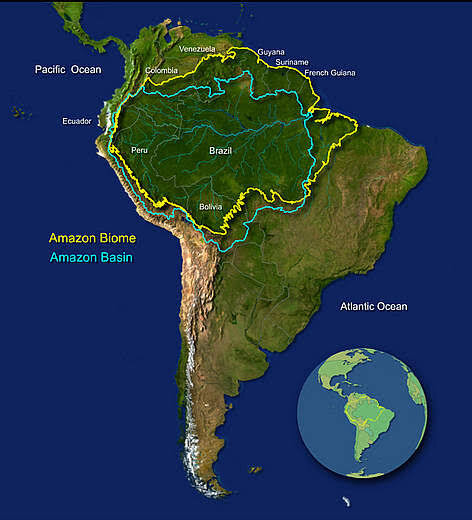Biodiversity & Environment
Amazon Forests: No Longer Carbon Sinks
- 16 Jul 2021
- 4 min read
Why in News
According to a recent study, Amazon Forests have started emitting Carbon dioxide (CO2) instead of absorbing it.
- Growing trees and plants have taken up about a quarter of all fossil fuel emissions since 1960, with the Amazon playing a major role as the largest tropical forest.
Key Points
- Findings:
- A significant amount of deforestation (over the course of 40 years) in eastern and southeastern Brazil has turned the forest into a source of CO2 that has the ability to warm the planet.
- It might have also affected a long-term decrease in rainfall and increase in temperatures during the dry season.
- Not only the Amazon rainforests, some forests in Southeast Asia have also turned into carbon sources in the last few years as a result of formation of plantations and fires.
- Forest fires have doubled since 2013. One reason that they happen is when farmers burn their land to clear it for the next crop.
- Most of the emissions are caused by fires.
- A part of the Amazon emitting carbon even without fires was particularly worrying. This was most likely the result of each year’s deforestation and fires making adjacent forests more susceptible the next year.
- A significant amount of deforestation (over the course of 40 years) in eastern and southeastern Brazil has turned the forest into a source of CO2 that has the ability to warm the planet.
- Reasons for Deforestation:
- State policies that encourage economic development, such as railway and road expansion projects have led to “unintentional deforestation” in the Amazon and Central America.
- Deforestation started in the 1970s and 1980s when large-scale forest conversion for cattle ranching and soy cultivation began.
Amazon Rainforests
- These are large tropical rainforests occupying the drainage basin of the Amazon River and its tributaries in northern South America.
- Tropical forests are closed-canopy forests growing within 28 degrees north or south of the equator.
- They are very wet places, receiving more than 200 cm rainfall per year, either seasonally or throughout the year.
- Temperatures are uniformly high - between 20°C and 35°C.
- Such forests are found in Asia, Australia, Africa, South America, Central America, Mexico and on many of the Pacific Islands.
- The Amazon rainforests cover about 80% of the Amazon basin and they are home to nearly a fifth of the world’s land species and is also home to about 30 million people including hundreds of indigenous groups and several isolated tribes.
- The Amazon basin is huge with an area covering over 6 million square kilometres, it is nearly twice the size of India.
- The basin produces about 20% of the world’s flow of freshwater into the oceans.
- Comprising about 40% of Brazil’s total area, it is bounded by the Guiana Highlands to the north, the Andes Mountains to the west, the Brazilian central plateau to the south, and the Atlantic Ocean to the east.
Way Forward
- If the ability of tropical forests to act as carbon sinks is to be maintained, fossil fuel emissions need to be reduced and temperature increases need to be limited as well.





